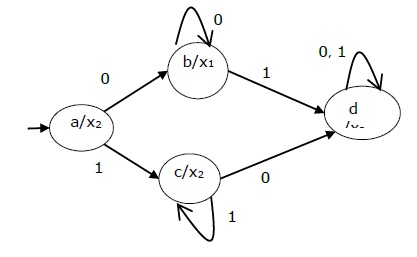- Android操作系统上小规模应用程序的资源利用(1)
- Android操作系统上小规模应用程序的资源利用
- 异常摩尔质量
- 异常摩尔质量(1)
- 摩尔浓度公式(1)
- 摩尔浓度公式
- 米利机和摩尔机的区别
- 米利机和摩尔机的区别
- 米利机和摩尔机的区别(1)
- 以摩尔为单位的浓度 (1)
- 摩尔机在 C++ 中的实现
- 摩尔机在 C++ 中的实现(1)
- 以摩尔为单位的浓度 - 无论代码示例
- 具有可教机器的机器学习模型
- 具有可教机器的机器学习模型(1)
- Python中的摩尔斯电码翻译器
- Python中的摩尔斯电码翻译器(1)
- Python中的摩尔斯电码翻译器
- 如何创建摩尔斯电码转换器 Android 应用程序?
- 如何创建摩尔斯电码转换器 Android 应用程序?(1)
- 从摩尔机到Mealy机的转换(1)
- 从摩尔机到Mealy机的转换
- 机器学习中的 P 值
- C++中的机器学习
- 机器学习中的 P 值(1)
- 机器学习 (1)
- C++中的机器学习(1)
- 痣的概念——什么是痣,摩尔质量,解决的例子(1)
- 痣的概念——什么是痣,摩尔质量,解决的例子
📅 最后修改于: 2020-11-26 10:09:57 🧑 作者: Mango
有限自动机可能具有与每个过渡相对应的输出。产生输出的有限状态机有两种类型-
- 机器
- 摩尔机
机器
Mealy机器是FSM,其输出取决于当前状态以及当前输入。
可以用6个元组(Q,∑,O,δ,X,q 0 )描述,其中-
-
Q是一组有限的状态。
-
∑是一组有限的符号,称为输入字母。
-
O是一组有限的符号,称为输出字母。
-
δ是输入转换函数,其中δ:Q×∑→Q
-
X是输出转换函数,其中X:Q×∑→O
-
Q 0是从那里的任何输入被处理(Q 0∈Q)的初始状态。
Mealy机器的状态表如下所示-
| Present state | Next state | |||
|---|---|---|---|---|
| input = 0 | input = 1 | |||
| State | Output | State | Output | |
| → a | b | x1 | c | x1 |
| b | b | x2 | d | x3 |
| c | d | x3 | c | x1 |
| d | d | x3 | d | x2 |
上述Mealy机器的状态图为-

摩尔机
摩尔机是FSM,其输出仅取决于当前状态。
摩尔机器可以由6个元组(Q,∑,O,δ,X,q 0 )描述,其中-
-
Q是一组有限的状态。
-
∑是一组有限的符号,称为输入字母。
-
O是一组有限的符号,称为输出字母。
-
δ是输入转换函数,其中δ:Q×∑→Q
-
X是输出转换函数,其中X:Q→O
-
Q 0是从那里的任何输入被处理(Q 0∈Q)的初始状态。
摩尔机的状态表如下所示-
| Present state | Next State | Output | |
|---|---|---|---|
| Input = 0 | Input = 1 | ||
| → a | b | c | x2 |
| b | b | d | x1 |
| c | c | d | x2 |
| d | d | d | x3 |
上面的摩尔机的状态图是-

Mealy机器与Moore机器
下表突出显示了区分Mealy机器和Moore机器的要点。
| Mealy Machine | Moore Machine |
|---|---|
| Output depends both upon the present state and the present input | Output depends only upon the present state. |
| Generally, it has fewer states than Moore Machine. | Generally, it has more states than Mealy Machine. |
| The value of the output function is a function of the transitions and the changes, when the input logic on the present state is done. | The value of the output function is a function of the current state and the changes at the clock edges, whenever state changes occur. |
| Mealy machines react faster to inputs. They generally react in the same clock cycle. | In Moore machines, more logic is required to decode the outputs resulting in more circuit delays. They generally react one clock cycle later. |
从摩尔机到小机
算法4
输入-摩尔机
输出-小机器
步骤1-采取空白的Mealy Machine过渡表格式。
步骤2-将所有摩尔机的过渡状态复制到此表格式。
步骤3-在摩尔机状态表中检查当前状态及其对应的输出;如果状态Q i的输出为m,则将其复制到Mealy Machine状态表的输出列中,无论Q i在下一状态出现的位置。
例
让我们考虑以下摩尔机器-
| Present State | Next State | Output | |
|---|---|---|---|
| a = 0 | a = 1 | ||
| → a | d | b | 1 |
| b | a | d | 0 |
| c | c | c | 0 |
| d | b | a | 1 |
现在我们应用算法4将其转换为Mealy Machine。
步骤1和2-
| Present State | Next State | |||
|---|---|---|---|---|
| a = 0 | a = 1 | |||
| State | Output | State | Output | |
| → a | d | b | ||
| b | a | d | ||
| c | c | c | ||
| d | b | a | ||
步骤3-
| Present State | Next State | |||
|---|---|---|---|---|
| a = 0 | a = 1 | |||
| State | Output | State | Output | |
| => a | d | 1 | b | 0 |
| b | a | 1 | d | 1 |
| c | c | 0 | c | 0 |
| d | b | 0 | a | 1 |
从机器到摩尔机
算法5
输入-计量机
输出-摩尔机
步骤1-计算Mealy机器的状态表中可用的每个状态(Q i )的不同输出的数量。
步骤2-如果Qi的所有输出都相同,则复制状态Q i 。如果它具有n个不同的输出,则将Q i分解为n个状态,作为Q ,其中n = 0、1、2 ……..
步骤3-如果初始状态的输出为1,则在开头插入一个新的初始状态,输出为0。
例
让我们考虑以下Mealy Machine-
| Present State | Next State | |||
|---|---|---|---|---|
| a = 0 | a = 1 | |||
| Next State | Output | Next State | Output | |
| → a | d | 0 | b | 1 |
| b | a | 1 | d | 0 |
| c | c | 1 | c | 0 |
| d | b | 0 | a | 1 |
在这里,状态“ a”和“ d”分别仅提供1和0输出,因此我们保留状态“ a”和“ d”。但是状态“ b”和“ c”产生不同的输出(1和0)。因此,我们将b分为b 0 ,b 1和c分为c 0 ,c 1 。
| Present State | Next State | Output | |
|---|---|---|---|
| a = 0 | a = 1 | ||
| → a | d | b1 | 1 |
| b0 | a | d | 0 |
| b1 | a | d | 1 |
| c0 | c1 | C0 | 0 |
| c1 | c1 | C0 | 1 |
| d | b0 | a | 0 |